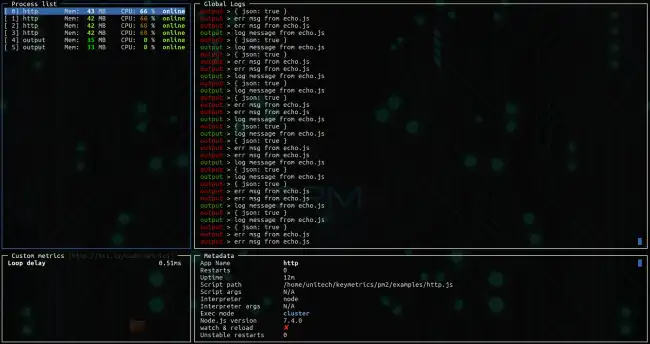PM2 is a process manager for Node.js applications that allows you to manage, monitor, and maintain applications in production.
Generally, when we develop Node.js applications, we run them directly with:
node app.jsBut this has several problems in production. For example, if the application crashes, it won’t restart, we have no easy way to monitor the status, etc.
PM2 solves all these problems by providing:
- Auto-restart of applications when they crash
- Monitoring and logs in real-time
- Load balancing across multiple instances
Notice about AGPLv3 license:
PM2 is distributed under the AGPLv3 license (GNU Affero General Public License). There could be potential obligations if:
- You deeply integrate PM2 into your application (creating derivative work)
- You offer PM2 as a public SaaS service (would require releasing modifications)
Installing PM2
To use PM2, we install it globally using NPM:
npm install -g pm2Now we can verify that it has been installed correctly by running:
pm2 --versionBasic usage of PM2
Starting an application
The basic command to start an application with PM2 is:
pm2 start app.jsWe can also specify a name for the application:
pm2 start app.js --name "my-api"PM2 automatically daemonizes the process (runs it in the background)
Essential commands
Here is a list of the main commands available in PM2.
| Command | Description |
|---|---|
pm2 list | Lists all managed applications |
| `pm2 show <id | name>` |
| `pm2 stop <id | name>` |
| `pm2 restart <id | name>` |
| `pm2 delete <id | name>` |
pm2 logs | Displays real-time logs |
pm2 monit | Interactive monitor |
And here is an example of its usage,
# Start application
pm2 start server.js --name "api-server"
# Check status
pm2 list
# View logs
pm2 logs api-server
# Stop application
pm2 stop api-server
# Delete application
pm2 delete api-serverStartup script
To ensure that PM2 starts automatically when the system reboots, we can do:
pm2 startup
pm2 saveThis will create an appropriate startup script for your operating system.
On Linux systems, the pm2 startup command should be executed with the appropriate permissions, usually via sudo
Cluster mode
Node.js is single-threaded by default. PM2 allows you to easily create a cluster of processes:
pm2 start app.js -i maxThis will create one instance for each available CPU, sharing the same port.
The cluster mode only works for stateless applications. If you use in-memory sessions, you will need a solution like Redis.
Monitoring and logs
PM2 includes a built-in monitor:
pm2 monit
Additionally, PM2 automatically manages the logs:
~/.pm2/logs/app-out.log: Standard logs~/.pm2/logs/app-error.log: Error logs
Some commands
# View logs in real-time
pm2 logs
# Flush logs
pm2 flush
# Specific app logs
pm2 logs app-nameAdvanced configuration with ecosystem files
For more complex configurations, PM2 supports configuration files (ecosystem.config.js):
module.exports = {
apps: [{
name: "api",
script: "./src/index.js",
instances: 2,
exec_mode: "cluster",
env: {
PORT: 3000,
NODE_ENV: "development"
},
env_production: {
PORT: 80,
NODE_ENV: "production"
}
}]
}instances: Number of instances (can be a number or “max” to use all CPUs)exec_mode: “cluster” or “fork”env: Environment variableswatch: Automatically restart on detecting changeserror_fileandout_file: Paths for the logs